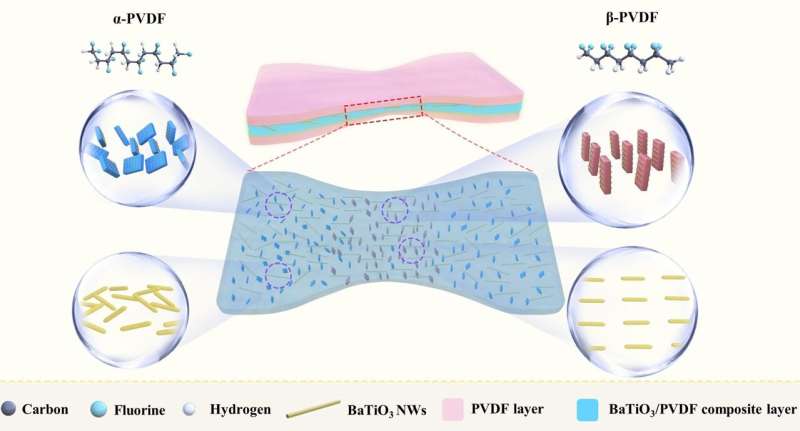by KeAi Communications Co.

The schematic diagram of microstructure evolution to achieve performance enhancement in stretched dielectric composites. Credit: Ru Guo, Hang Luo
Electrostatic capacitors are a key component in high-power pulse equipment, power transmission and transformation engineering, new energy vehicles, and 5G communication. Their capability for ultrafast charging-discharging and ultrahigh power density is pivotal for their performance.
Nonetheless, their relatively low capacitance and energy density restrict their rapid development toward the lightweight, flexible, integrated trend in electrical and electronic equipment. Overcoming the energy density bottleneck for dielectrics has thus become a research hotspot that urgently needs attention.
Electric breakdown strength and permittivity, or polarization, are two key parameters for high energy density in the dielectric. One of the most common strategies involves incorporating various ceramic nanoparticles such as BaTiO3, SrTiO3, among others, into high-insulation polymer matrix to leverage their respective advantages. However, achieving a significant increase in permittivity often requires a high loading of nanoparticles, which tends to increases electrical conductivity, thereby compromising the breakdown strength.
In a study published in the journal Advanced Powder Materials, a team of researchers from Central South University in Changsha, China, proposed a novel facile strategy to realize collaborative enhancement of breakdown strength and electric polarization for dielectric.
“Our strategy allows us to simultaneously achieve construction of in-plane oriented BaTiO3 nanowire fillers and crystallization modulation of polyvinylidene fluoride (PVDF) matrix in an in-situ uniaxial stretch process,” explains the study’s senior and corresponding author Dou Zhang.
Compared with zero-dimensional nanoparticles, one-dimensional nanowires with high aspect ratios have high polarizability and large dipole moment in the longitudinal direction, rendering them more effective in improving the permittivity of composite at lower loading levels while maintaining electric field endurance.
The research proved that high-strain stress induced the ultrahigh polar β phase and enhanced Young’s modulus, facilitating a concurrent increase in both electric displacement and breakdown strength of polymer matrix. Notably, finite element simulation results revealed the oriented distribution of nanowires favors reducing the contact probability of nanowire tips, thus alleviating electric field concentration and hindering the breakdown path.
“The newly designed stretched PVDF-based nanocomposite is capable of operating with a voltage endurance as high as 843.0 kV/mm and simultaneously delivering an energy density of 40.9 J/cm3. This is by far the best capacitive performance ever achieved in polymer dielectrics,” adds Zhang.
More information:
Ru Guo et al, Ultrahigh energy density in dielectric nanocomposites by modulating nanofiller orientation and polymer crystallization behavior, Advanced Powder Materials (2024). DOI: 10.1016/j.apmate.2024.100212
Provided by
KeAi Communications Co.
Citation:
Strategy enhances breakdown strength and polarization in dielectric nanocomposites (2024, July 17)
retrieved 18 July 2024
from https://phys.org/news/2024-07-strategy-breakdown-strength-polarization-dielectric.html
This document is subject to copyright. Apart from any fair dealing for the purpose of private study or research, no
part may be reproduced without the written permission. The content is provided for information purposes only.
>>> Read full article>>>
Copyright for syndicated content belongs to the linked Source : Phys.org – https://phys.org/news/2024-07-strategy-breakdown-strength-polarization-dielectric.html










